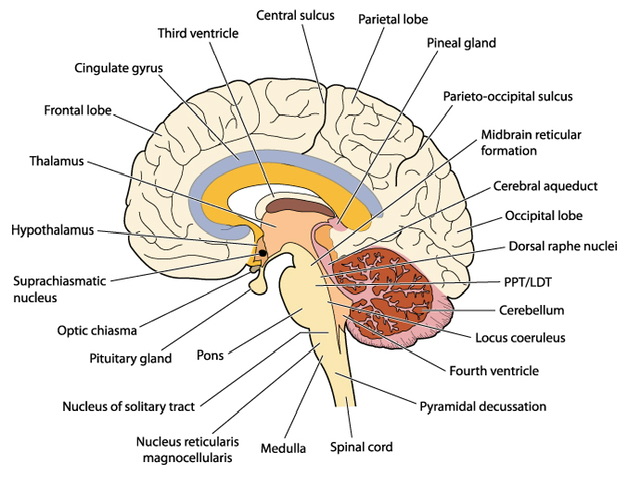We'll be back in a bit !
The system is currently undergoing a routine upgrade to ensure you get the best learning experience. The maintenance is expected to continue till 8:00 pm. Please check back later.
Thank you for your understanding!

The human brain is the central nervous system organ placed in the head and is protected by the skull. It is composed of over 100 billion nerve cells, or neurons, and trillions of glial cells, which provide support and protection to the neurons. The cerebrum, cerebellum, and brainstem are the three major regions of the brain.
Cerebrum
The cerebrum is the largest part of the brain, and it is divided into two hemispheres, the left, and the right. Each hemisphere is further subdivided into four lobes: the frontal, parietal, temporal, and occipital lobes. The cerebrum is responsible for conscious thought, memory, and processing of sensory information.
Cerebellum
The cerebellum is positioned near the base of the brain, beneath the cerebrum. It is in charge of coordinating voluntary motions including posture, balance, and coordination.
Brainstem
The brainstem links the brain and the spinal cord and is in charge of many of our involuntary activities, such as breathing, heart rate, and blood pressure.
Thalamus
This portion of the brain serves as a relay center, sending sensory information to the proper sections of the brain for processing.
Hypothalamus
This small but crucial part of the brain regulates a variety of functions, including body temperature, hunger, thirst, and sleep.
Hippocampus
This part of the brain is critical for forming new memories and spatial navigation.
Amygdala
This small structure plays a role in processing emotions, particularly fear and aggression.
Structure of the Human Brain
Neurons are the fundamental building elements of the nervous system and communicate with one another via synapses. A synapse is a small gap between neurons, where neurotransmitters are released to transmit signals from one neuron to another.
Structure of a Neuron
A neuron consists of a cell body, dendrites, and an axon. The cell body contains the nucleus and other components, and dendrites receive messages from other neurons. The axon is a long, thin structure that transmits messages from the cell body to neighboring neurons or muscles.
Synaptic Transmission
When an action potential reaches the axon terminal, it triggers the release of neurotransmitters into the synapse. These neurotransmitters then bind to receptors on the dendrites of the next neuron, causing an electrical signal to be generated and transmitted along the axon.
The Synaptic Transmission
The brain serves a variety of functions that are critical for our survival, as well as our ability to think, feel, and interact with the world around us. Some of the key functions of the brain include:
Cognitive function: The brain is responsible for our ability to think, reason, learn, and remember. It processes information from our senses and integrates it into our understanding of the world.
Motor function: The brain controls our ability to move, both voluntarily and involuntarily. It coordinates the activity of our muscles, allowing us to walk, talk, and perform other physical tasks.
Sensory function: The brain processes information from our senses, allowing us to see, hear, taste, touch, and smell the world around us.
Emotional function: The brain plays a critical role in regulating our emotions and influencing our behavior. It helps us experience and express a wide range of emotions, from happiness and joy to fear and sadness.
Autonomic function: The brain controls many automatic functions of the body, such as breathing, heart rate, and digestion.
Hormonal function: The brain regulates the production and release of hormones, which are essential for maintaining a healthy body and mind.
Disorders of the brain can have a profound impact on a person's life, and there are many different types of brain disorders. Some of the most common include:
Alzheimer's Disease
Alzheimer's disease is a degenerative brain ailment that impairs memory, cognition, and behavior. It is distinguished by the buildup of aberrant proteins in the brain, which causes brain cell death.
Parkinson's Disease
Parkinson's disease is a degenerative nervous system ailment that impairs mobility. The loss of dopamine-producing neurons in the brain characterizes it.
Epilepsy
Epilepsy is a neurological illness characterized by recurring seizures caused by aberrant electrical activity in the brain.
The human brain is a complex and fascinating organ that is responsible for controlling many of the body's functions. It is composed of over 100 billion neurons and trillions of glial cells, which work together to transmit signals throughout the nervous system. Understanding the structure and function of the brain is essential for understanding many different aspects of human behavior, and ongoing research is helping to shed new light on this remarkable organ.
Grey matter refers to portions of the brain made up of cell bodies and dendrites, whereas white matter refers to sections made up of axons.
While the brain has some capacity for regeneration, it is limited, and many types of brain damage can lead to permanent impairment.
The blood-brain barrier is a specialized network of blood arteries that protects the brain from potentially dangerous compounds in the blood.
